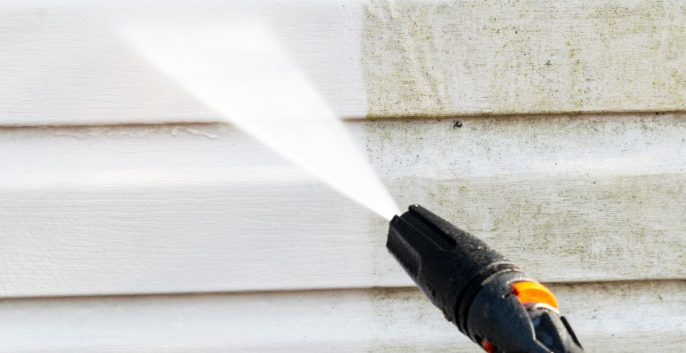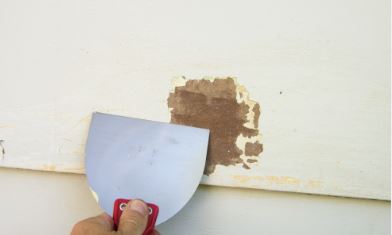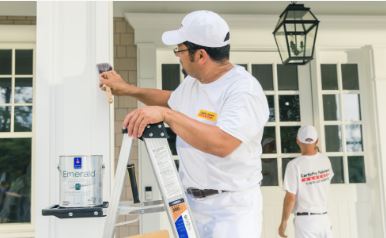The Exterior Painting Process
Chapter 6
Chapter 6: The Exterior Painting Process – tips unique to the South Shore, MA area.
During the painting of your home’s exterior:
It’s important that you stay actively involved in the process to make sure the painter executes your vision for your home’s exterior. In general, the following should happen:
The office staff should communicate with you an approximate start window. Since New England weather is notoriously wet, most painters in our area won’t be able to give you an exact start date.
 The painting company may powerwash your home a few days before starting the prep and painting phase.
The painting company may powerwash your home a few days before starting the prep and painting phase.
You will need to keep your windows closed and let them know of any leaks so they can avoid getting the inside of your home wet during the power washing.
The first day of the job should include a meeting with you to be sure everyone is on the same page.
It may have been a while since you got your quote, so reviewing the scope of work with the Job Site Supervisor to ensure the painters execute your vision is imperative. Walking around your home usually takes only 10 minutes but is one of the best ways to prevent issues and misunderstandings.
If your painter is also replacing rotted wood so common in Boston-area homes, the carpenters may start working the first day to replace shingles, rotted trim boards, or clapboards.
.
Painters will prepare the surface of your home according to the contract before they begin painting.
Before painting, the painters may ask you to approve the color by painting paint swatches on a small area. If you don’t like the color now, you won’t like it later – so speak up!
<!– –>Painters will roll, spray, and back-roll your home and brush-paint the detailed areas.
–>Painters will roll, spray, and back-roll your home and brush-paint the detailed areas.
Drop cloths should be used outside to catch paint chips and also to protect your landscaping and decks and porches.
Communication during the painting project
If issues arise, communicate fast with the painting company.
A good painting company will have supervisors stop at your project to ensure you are happy and the painters are painting safely.
What if I change my mind in the middle of the job? It happens!
Communicate with your painting crew as soon as possible.
Color changes are sometimes easy if caught early on. The more the painters paint a color you don’t like, the more expensive it will be to repaint that area.
If you find areas that need painting that weren’t quoted initially, let the crew know you might like to add them to the job. Adding a shed or a pool house while the painters are already on-site often saves you a “trip charge” the painter might have to charge you if you paint your shed at another time.
Get all add-on quotes in writing. You may be asked to sign off on them before the crew proceeds with the work.
The stages of painting:
How long the painting will take will depend on our project’s specifics, but a good painter can give you a rough idea of the time frame. In general, a 2,500 square foot home, with a 4-person painting crew, will generally take 3-5 sunny days from start to finish.
Surface preparation or “prep.”
You’ve heard it, and it’s true – good preparation is the key to a great painting job. Prep includes:
Cleaning the surface to remove any dirt or debris usually involves power or hand washing your home.
Filling the gaps with caulk and holes caused by woodpeckers of the South Shore
Sanding the surface
Taping and putting up plastic to protect areas that are not getting painted
Priming:
Priming is the process of adding a special type of paint (called primer) to the exterior surface of your home to get it ready for the top coats of paint that will follow.
In some instances, priming your exterior is not necessary, but oftentimes it is a necessary step. For example, you should always prime unpainted wood. Rely on the expertise of your painter to decide if priming is essential for your exterior.
If you are adding new trim boards to your home, the carpenter should “prime the cuts” before installing them. This way the cut edges of those new boards are protected.
Depending on your contract with your painter, you’ll either have no priming, a spot prime which is just priming over the areas that have bare wood showing, or a full-prime – priming over all surfaces before paint is applied.
Painting:
Painting requires brushes and sprayers, rollers, and it may require one or multiple coats.
The paint brand and grade are important to get right because using a great quality paint always pays dividends in the project’s longevity.
If you need your home painted quickly, ask the painter to use a larger painting crew.
Good contractors will also minimize disruption to your household by storing their tools out of the way and using the bathroom offsite.
Inspection and Touch-Ups:
After the painter applies the paint and inspects it, it’s time for touch-ups.
You should walk around unhurried because you might see places that the painter “just doesn’t see” after looking at your home for days, so point out any spots you’d like touched up.
Do your walk around your home while it’s still light out to ensure everything in the contract has been executed.
Cleaning up:
This involves: Removing all tools and materials, taking down the plastic, paper, and tape, and removing any exterior drop cloths.
Ensure the painter has thrown away all trash and vacuumed all paint chips. Have them bring all trash home with them.
If your home had lead paint on it, clean up will involve vacuuming all of the lead paint chips and disposing of them off-site.
Touch-up paint:
If paint is leftover, have the painter label it with your exterior’s different areas (i.e., shutters, doors, bulkhead) and leave it for you.
Store the extra paint in a cool, dry place and if you need to touch up the paint in the future, be sure to test it in an inconspicuous area.
The sun on the South Shore tends to beat down on our homes, especially if your house faces south, so if the color of your home fades slightly, touching up an area with 3-year old paint might cause the house to look spotty in places you’ve touched up.
If you need to touch up your home a few years later, start in an inconspicuous spot first to ensure the color still blends well.
Warranties
Many painting companies offer warranties for their work. This is good in New England since moisture is the number one reason paint might peel.
If you have a written guarantee, you won’t have to worry if this happens as long as the painter returns to fix the problem.
Even good painters have projects where the paint fails, so given the Boston climate, you must have a warranty in writing.
Need help with an exterior painting project? Set up a free estimate online.


